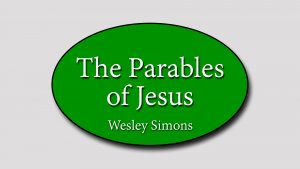-
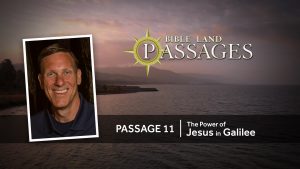
Passage 11 | The Power of Jesus in Galilee
Situated some 690 feet below sea level, Israel’s largest fresh water lake and its surrounding majestic hills form the backdrop to some of our Lord’s most dramatic miracles. Complete with epic footage of the Sea of Galilee and compelling reenactments, The Power of Jesus in Galilee is a vivid and powerful documentary highlighting the miracles of Jesus in and around the ancient city of Capernaum and its environs. From the middle of the lake to the exploration of several ancient synagogues, Bible Land Passage filmmakers take you on a journey to where Jesus demonstrated his power over disease, demons, and the forces of nature. With a unique approach to examining and combining the archaeological evidence, geographical environs, and the gospel accounts, The Power of Jesus in Galilee will transport viewers back in time to a place where Jesus revealed his divine power. It will likewise show that just as the winds and the sea obeyed Him, so should we.
-
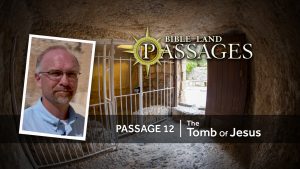
Passage 12 | The Tomb of Jesus
All four Gospel accounts speak of Jesus being led by the Jewish leaders to the presence of the governor, Pontius Pilate. Upon Pilate’s sentence, Jesus was led to Golgotha outside the walls of the city where He was crucified. When He passed away that Friday afternoon, friends took His body to be buried near where the execution occurred. Yet location of this burial site has been a topic of interest since antiquity. Passage 12: The Tomb of Jesus explores the most likely sites for Jesus’ burial, the Garden Tomb and the Church of the Holy Sepulcher, and provides an assessment for each as His possible burial places. Utilizing the details from the gospel narratives and the results of study into funerary practices in ancient Israel, this documentary highlights the rich imagery and history that has been associated with Jesus’ resting place. It concludes by reminding the viewer that even if the exact location were known, all one would find, then and now, is an empty tomb.
-
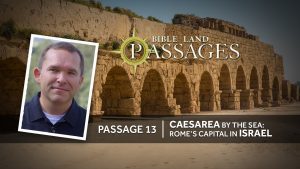
Passage 13 | Caesarea by the Sea: Rome's Capital in Israel
"Caesarea by the Sea: Rome’s Capital in Israel" is an exciting documentary about the city and culture where Christianity faced the challenges of a pagan world, and where a Roman Centurion was baptized into Christ. Utilizing enhanced 3D digital models, Bible Land Passages will take you on a fantastic voyage into first-century Caesarea, where you will marvel at the construction of an artificial harbor and see numerous public buildings and facilities built by King Herod the Great. Dedicated to the Roman Emperor Caesar Augustus, Caesarea Maritima boasted a large aqueduct, beautiful bathhouses and fountains, a theater, a hippodrome, and a luxurious palace with a freshwater swimming pool perched on the edge of the beautiful Mediterranean. It was an impressive and technologically advanced city, but even more memorable and more impressive are the stories of the Christian men and women in Caesarea who courageously served Jesus in the face of tremendous decadence and paganism. Join us on this faith-building journey to a city built some two-thousand years ago, and see how God used this powerful Roman city as a means of spreading the gospel all over the world.
-
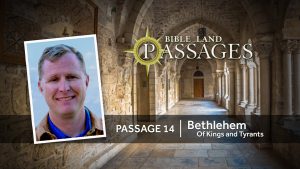
Passage 14 | Bethlehem: Of Kings and Tyrants
The town of Jesus’ birth and the burial site of King Herod are situated only 3 miles apart. The Herodium, with the remains of its grand palace and stately mausoleum, stands as a bleak reminder of an egocentric megalomaniac king who committed genocide. Bethlehem's beautifully adorned "Church of the Nativity" is dedicated to the birth of Christ, and it stands as a testament to the peaceful and loving ministry of a man who died that others might live. But does this venerated church building with its traditional birth grotto beneath its altar mark the actual place where Jesus was born? And what does the Herodium tell us about the king who tried in vain to kill the baby Jesus? Join us on this faith building journey across the historic and beautiful Judean Hills of Israel. See each of these sites through the lens of our camera crew, and walk virtually through the 3D digital models of these historic places. Bible Land Passages' documentary “Bethlehem: Of Kings and Tyrants” provides an exciting, modern perspective on these classic and well-known stories of the ancient past.
-
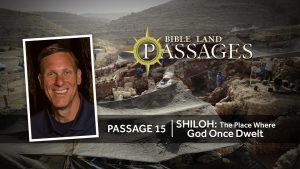
Passage 15 | Shiloh: The Place Where God Once Dwelt
Nestled deep within the heartland of the West Bank in Israel lies the biblical city of Shiloh; the place where God’s tent of meeting was located for over 300 years. Today this storied city lies in ruin, but archaeologists are determined to unearth its secrets. In recent years a number of important discoveries have been unearthed in Shiloh and Bible Land Passages was there to document the evidence, discuss the significance, and provide faith-building lessons from the land of the Bible.
Passage 12 | The Tomb of Jesus
Description
All four Gospel accounts speak of Jesus being led by the Jewish leaders to the presence of the governor, Pontius Pilate. Upon Pilate’s sentence, Jesus was led to Golgotha outside the walls of the city where He was crucified. When He passed away that Friday afternoon, friends took His body to be buried near where the execution occurred. Yet location of this burial site has been a topic of interest since antiquity. Passage 12: The Tomb of Jesus explores the most likely sites for Jesus’ burial, the Garden Tomb and the Church of the Holy Sepulcher, and provides an assessment for each as His possible burial places. Utilizing the details from the gospel narratives and the results of study into funerary practices in ancient Israel, this documentary highlights the rich imagery and history that has been associated with Jesus’ resting place. It concludes by reminding the viewer that even if the exact location were known, all one would find, then and now, is an empty tomb.










